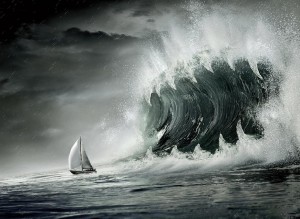Double-check your gear, take some lessons and have a backup plan

I knew enough about sailing I guessed, but my wife thought otherwise, and so I settled on purchasing something smaller, a day sailing vessel. I went on Craigslist and found the perfect thing – a little 13 foot O’Day sailboat, with room for myself and a couple kids. Perhaps I could even convince my wife to venture out with me and a picnic basket. I contacted the owner and hatched a plan to purchase the boat, with trailer, on our annual excursion to Mooselookmeguntic Lake in Maine.
I knew my wife wouldn’t have patience for the transaction and so I took our boys to close the deal at a sprawling farm near the lake. The owner said he had never sailed the 1973 O’Day but had all the rigging, sails, and original paperwork. It appeared to be neglected, fairly unused, yet preserved well beneath a canopy of tarps to shelter the boat throughout the winter months. I handed over the $800, hitched the trailer and boat to our van and rolled off to our vacation camp to admire the boat.
The lake is over 16,000 acres and runs predominantly north-south. Our cabin was situated on the south-east shore of the lake, and there was a nice boat ramp on the southern end of the lake, perhaps 2 miles from our camp rental. Perfect. I made a plan to launch the boat at the south end, sail east around Toothaker Island and then north a mile or so to our camp. A perfect maiden voyage to test the vessel and my skills.
The following morning we towed the boat to the launch, and I inexpertly rigged the sails and mast. In a last-minute decision I decided not to bring my oldest son, who looked longingly from the beach as I set out. It proved to be a smart decision.
Of course I hadn’t checked the wind direction or strength or developing weather, and set out with cheerful smiles from the little boat. What I didn’t know was that the wind was developing quickly, and increasing in intensity from the north. To get home I would be sailing into strengthening wind. And from where I launched the boat I was sheltered by Toothaker Island just a half mile north of me. As I approached the end of the island intending to tack north, I saw whitecaps and wind whipping directly ahead where the island shelter ended and the open uninterrupted lake started.
Then as I neared the end of the shelter of the island I noticed my feet were getting wet. I looked down to discover water streaming up from the bottom of the boat and realized I had forgotten to plug the drainage hole with the steel plug I left in the car. No problem, I place one foot firmly on the hole to stop the leak, and struggle to maintain a straight line across the wind.
So it goes, as I near the open lake and the wind increases unprotected by the island, I pull hard on the tiller to maintain course, and something snaps. It’s a thing I learn later is called a pintle. It’s what holds the rudder in place. Half of it broke off. Now as the open lake approaches, and the racing winds increase, I’m suddenly aware I’m in a strange boat, with an open hole in the bottom covered only by my foot, a wobbly rudder, and a mile of open water ahead.
I have perhaps a minute or two before I clear the end of the island and take the full force of the winds broadside. The far east coast of the lake is perhaps a mile or more away. I think about ditching, turning into the rocks on the end of Toothaker Island. If I wait any longer at all, I’ll be beyond the shelter of the island and into the lake, and in the swell of the waves and the full strength of the wind. Testing the tiller I find I have almost no ability to climb the wind, I can’t turn north, toward home.
Here’s my thought process: If I ditch into the rocks of the island, I’ll be safe, yet lost alone on an uninhabited small island, with the boat likely damaged. If I continue into the open swells and increasing winds, the tiller could either snap completely off, or possibly hold at least until I make land on the far side. If the remaining pintle fails and the rudder comes loose altogether, then I’m set adrift. I’ll simply drop the mainsail and drift with the wind and waves to the south end of the lake. I decide sinking won’t happen. I have no experience to know this is true as the water seeps past my foot covering the hole and the waves wash over the side, but I’m confident in my hunch.
I go for it. The winds increase as I leave the protected lee of the island, and I loosen the mainsail to dump the wind, and somehow manage an agreement between the wrecked rudder and the winds to hold a course directly east to the far side.
Miraculously, I land on the only little beach on the whole rocky coast, which happens to also be at the home of a lovely couple who take me in, dry my off, and offer a ride home to my camp. I decline the ride of course, because of pride and the need to digest the adventure on my walk around the lake back to our cabin.
Over the next few days I made trips to the hardware store, did some homework on boats and sailing, fixed the rudder and sailed it safely back to our cabin. Taking calculated chances makes for good memories and adventures. But check your gear, take some lessons first, have a backup plan, and take a deep breath.



